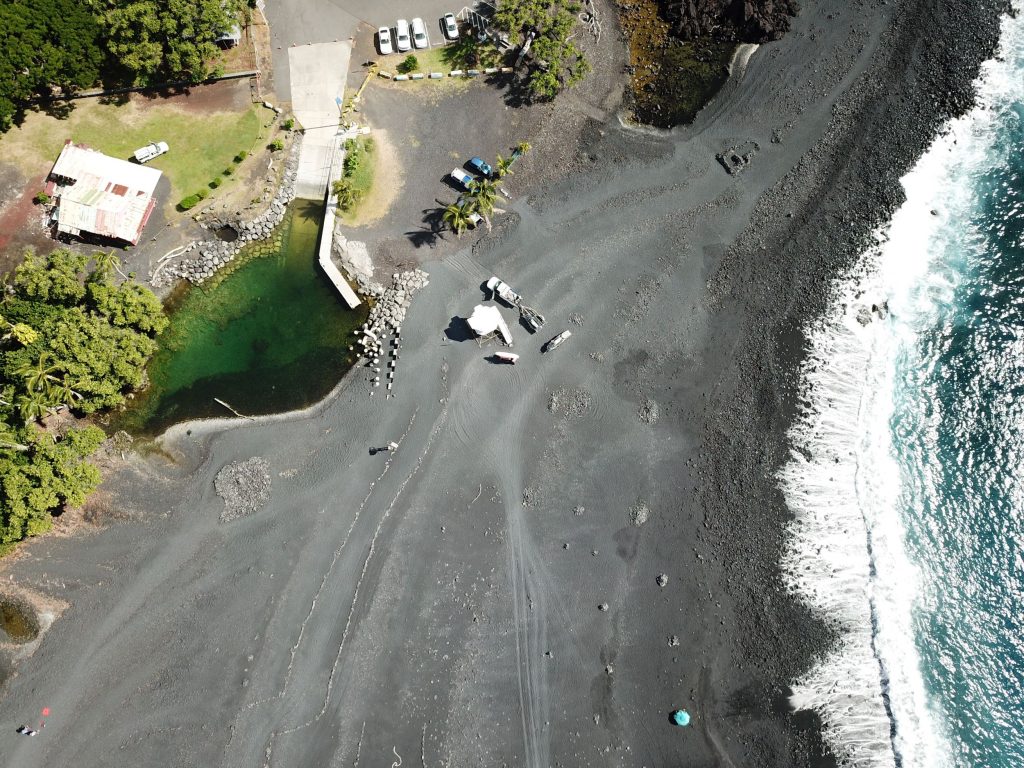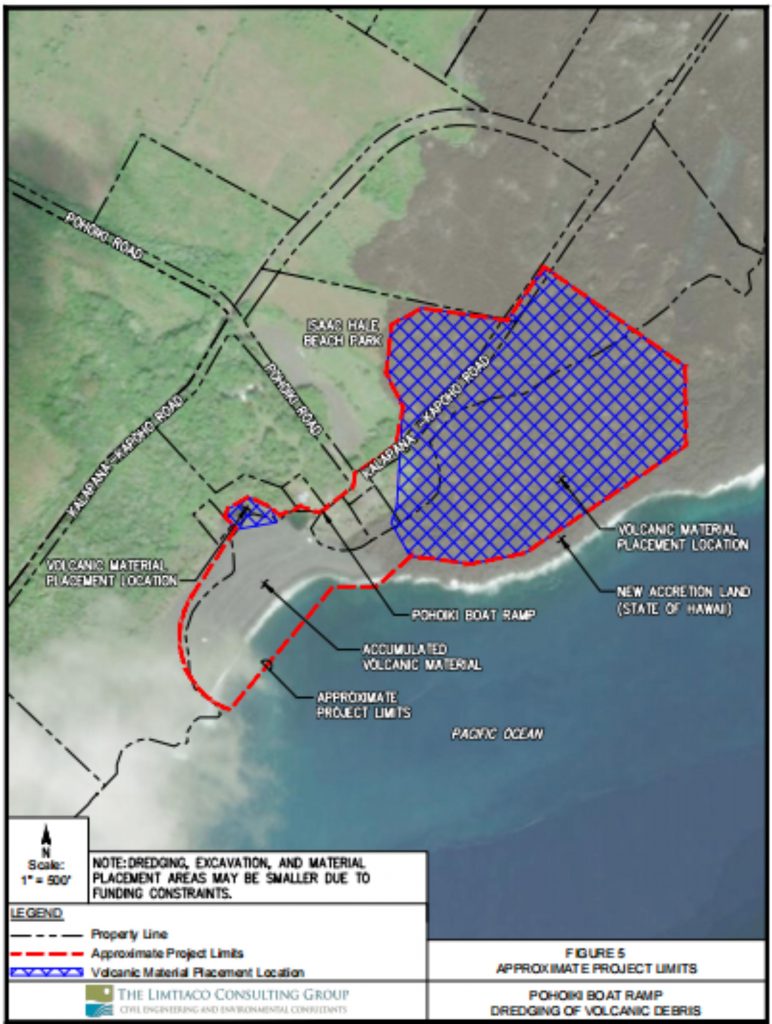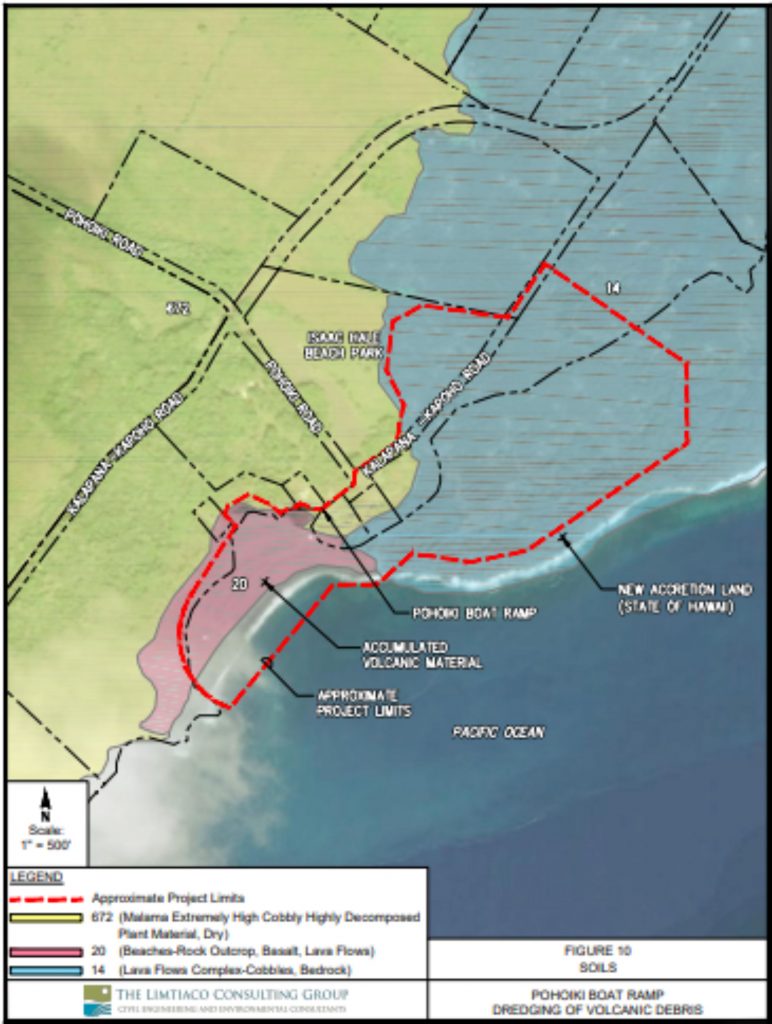Fisherman’s wife says studies are done; time to reopen ocean access to Pohoiki boat ramp
Five years after volcanic debris from the 2018 eruption of Kīlauea left the Pohoiki boat ramp in Puna landlocked, a nearly two-hour online public meeting was conducted Wednesday to discuss the proposed dredging and excavation plan to finally reopen the ocean access.

Some people hoped the state Department of Land and Natural Resources would save the hot ponds that were created by the blocked ocean access, saying they draw hundreds to the Pohoiki area.
Others, including the Hawai‘i Department of Health, say the hot ponds are hotbeds for bacteria and have become a nuisance, attracting undesirable activities such as nude swimming, littering and trespassing.
But the majority of the more than 90 participants of the meeting — conducted via Zoom by the state Division of Boating and Ocean Recreation and its consultant The Limtiaco Consulting Group — agreed the objective should be to remove the created black sand beach and return ocean access to Pohoiki for the fishermen, emergency rescue services and other commercial, recreational and food subsistence activities that have relied on the boat ramp for decades.
That majority even included many of those who spoke about saving the new hot ponds; those who had other concerns such as protecting coastline properties from erosion, preserving cultural areas to the south of the bay and safeguarding pre-existing warm springs not destroyed by the eruption; and Bunny Harrington, the wife of a longtime commercial fisherman from Pohoiki who has had to endure longer, more costly and more dangerous trips because of the unusable boat ramp.
“This has changed my life more dramatically than 99 percent of you in this chatroom,” she said. “… Everybody is talking save the warm ponds. What about the assessment? This, that. You guys don’t understand that we have been doing this from Day 1. The studies have been done. The ramp needs to be put back.”
The meeting Wednesday was to discuss the draft environmental assessment for the proposed dredging and excavation of the black sand beach created by the volcano. After many public meetings, it was the number one option by both the state and the Puna community.
The boat ramp facility was constructed in 1963 by the U.S. Army Corps of Engineers at the site of a former wharf. A 90-foot breakwater was completed by the corps in 1979 to protect the ramp. Maintenance dredging started in 1999 and was finished in 2001. The Division of Boating and Ocean Recreation, which now owns and maintains the facility, replaced the entire boat ramp in 2008. The boat ramp has been vital to the community.
Then came the Kīlauea eruption, which caused lava to enter the ocean on July 12, 2018, about 0.9 miles northeast of Pohoiki Bay. It advanced to approximately 230 feet southeast of the boat ramp by Aug. 6. A week later, the ramp was blocked by volcanic material.

Pohoiki Bay was about 1,000 feet wide at the mouth and extended approximately 450 feet inland before the lava flow drastically altered the nearshore environment. The bay has been reduced to just a few areas of trapped water. The boat ramp was undamaged but cut off from the ocean.
The state plans to dredge most of the bay and excavate about 11 acres of the accumulated sand, rock and cobble that currently blocks ocean access and restore it to a shape and depth that resembles pre-eruption conditions as much as possible with available funding.
The volcanic material removed, about 175,000 cubic yards, would be placed in areas of new lava or new beach owned by the state, away from the ocean. Some would be used to fill in the hot ponds in question and some would even be strategically placed to leave a buffer between the existing shoreline and where it would be that could help areas already suffering from erosion.
The draft environmental assessment states that the proposed project is not likely to significantly impact the physical or human environment of Pohoiki.
Eleven community meetings and discussions were conducted in person and online prior to Wednesday’s online meeting, including during Revitalize Puna workshops in Pāhoa, to gather public input. The proposed project, which is the preferred option of the state and Puna community, was presented at an Aug. 18, 2022, meeting at the Pāhoa Community Center.
Alternatives were evaluated by coastal engineering consultants, including dredging channels through the new beach, placing marine mattresses to protect the dredge slopes from erosion, construction of large jetty structures to protect the boat ramp entrance channel and doing nothing, which was never really an option. The state also looked at other sites to construct a new boat ramp facility, but none were determined to be feasible for reasons ranging from high sea cliffs, rough ocean conditions and cultural and historical considerations.
“As time passed after the eruption ceased, it was observed that the accumulation of debris in Pohoiki Bay had stabilized and the prevailing trade wind currents had begun eroding the north side of the bay where the entrance channel to the existing boat ramp is located,” said Finn McCall, engineer with the Division of Boating and Ocean Recreation. “Pohoiki Bay, and the newly accreted lava flow from the 2018 eruption, provides the only location along the Puna coastline with natural protection from the rough sea conditions along the coastline. Although, it is still pretty rough.”
The option to remove a majority of the volcanic debris from the bay is also less costly than large jetty structures with dredging between them; and it requires much less time to obtain permits and complete construction, McCall said.
The project would be funded by the state, with the hopes of being reimbursed for most of the cost by the Federal Emergency Management Agency, but there’s been no formal commitment from the feds. No county funds would be used for the project.
Hawai‘i legislators recently approved $5.4 million for the dredging in their biennium state budget. However, an initial estimate in 2022 said the project would likely cost about $40 million.
The Hawai‘i County Council last month adopted a resolution urging the Hawai‘i Legislature to include that $40 million as a line item in the state budget. Hawai‘i Gov. Josh Green also included the $40 million in his budget request.
Big Island Rep. Greggor Ilagan said in a May 2 Facebook post that he and Big Island Sen. Joy San Buenaventura, both of whom represent Puna in Honolulu, started the 2023 state legislative session hoping to raise the $40 million from state and federal agencies to reopen the boat ramp. Unfortunately, the lack of response from FEMA resulted in the dredging project being left out of the state budget.
Instead, the two legislators were able to secure the $5.4 million to fund what Ilagan calls in his post “an alternative, more modest dredging option,” allowing the work to begin sooner rather than later and not leaving the project to languish for another year, waiting for state funds.
John Katahira, principal engineer at The Limtiaco Consulting Group, the Honolulu-based firm hired by the state to develop the reopening plan for the boat ramp, said during Wednesday’s meeting that the project will be made scalable so it can be done with the resources available at the time.
The draft environmental assessment was published April 23. The state expects to have its pre-final design completed by May 15, with the final environmental assessment hopefully published in July and a final design in place by Sept. 4. If everything goes as planned, the project could be put out for bid by the end of October with an estimated completion date by June 2024.
Katahira admitted it’s impossible to appease everyone, but guaranteed all voices would be heard. The comments and concerns put forth by the public Wednesday night will be taken into consideration and included in the final environmental assessment, along with written comments. There also is still time to weigh in on the draft assessment; the deadline for written comments is May 23.
The public also will be kept apprised as the project proceeds.
“Right now, the biggest concern is to get access to our ocean,” said Leila Kealoha, a fisherman and resident of the Pohoiki area. “This has been a really difficult time all these years.”
She pleaded for people to understand that Pohoiki is Puna’s ice box and it’s time to move forward with the project to restore ocean access to the boat ramp. There’s also urgency as prices for fish skyrocket while fishermen and their families foot hefty sums just so they can fish.
Harrington agreed, giving her passionate testimony while sitting at a traffic light. She was on her way to get food for her husband who is going fishing Thursday morning. His journey will be much longer, three nights and four days on the ocean, because he now must launch from Hilo to get to the Pohoiki fishing grounds. The situation also has made his fishing trips more dangerous.
He and another longtime fisherman from the area were caught in bad weather last week while fishing at Pohoiki. They huddled together as the sea tossed around his boat, with waves crashing over the sides. There was nothing else they could do as thunder and lightning clashed above. They had no quick way home, the Hilo boat ramp — now the only one available along the eastern coastline of the island until you get to South Point — was miles away. They were scared.
“My husband’s life is in jeopardy to feed the Big Island, and you know what? He absolutely loves it. He would never give up the job of a lawai‘a (fisherman),” Harrington said as her voice quivered with emotion. “My husband is proud to be a lawai‘a, and you guys, as our community, should be proud to stand behind the lawai‘a that is willing to risk their lives for this.”
She added: “Right now is graduation. You guys ready to pay $25 a pound for ahi? Because my husband just put $800 in fuel today. That’s not even bait. That’s not even ice. I get $150 worth of food for him to sustain while he’s out there fishing, and God willing bring him home safely to me just so everybody around here can enjoy the fish.”
Wednesday’s meeting was recorded and can be found under “Announcements” on the Division of Boating and Ocean Recreation website. The draft environmental assessment also can be viewed online.
Comments can be sent via email to McCall at [email protected] or via regular mail at State of Hawai‘i, DLNR – DOBOR, 4 Sand Island Access Road, Honolulu, HI 96819. A copy of comments also is requested to be sent to Trevor Vagay, project manager with Limtiaco, via email at [email protected] or via regular mail at The Limtiaco Consulting Group, 1622 Kanakanui St., Honolulu, HI 96817.



















